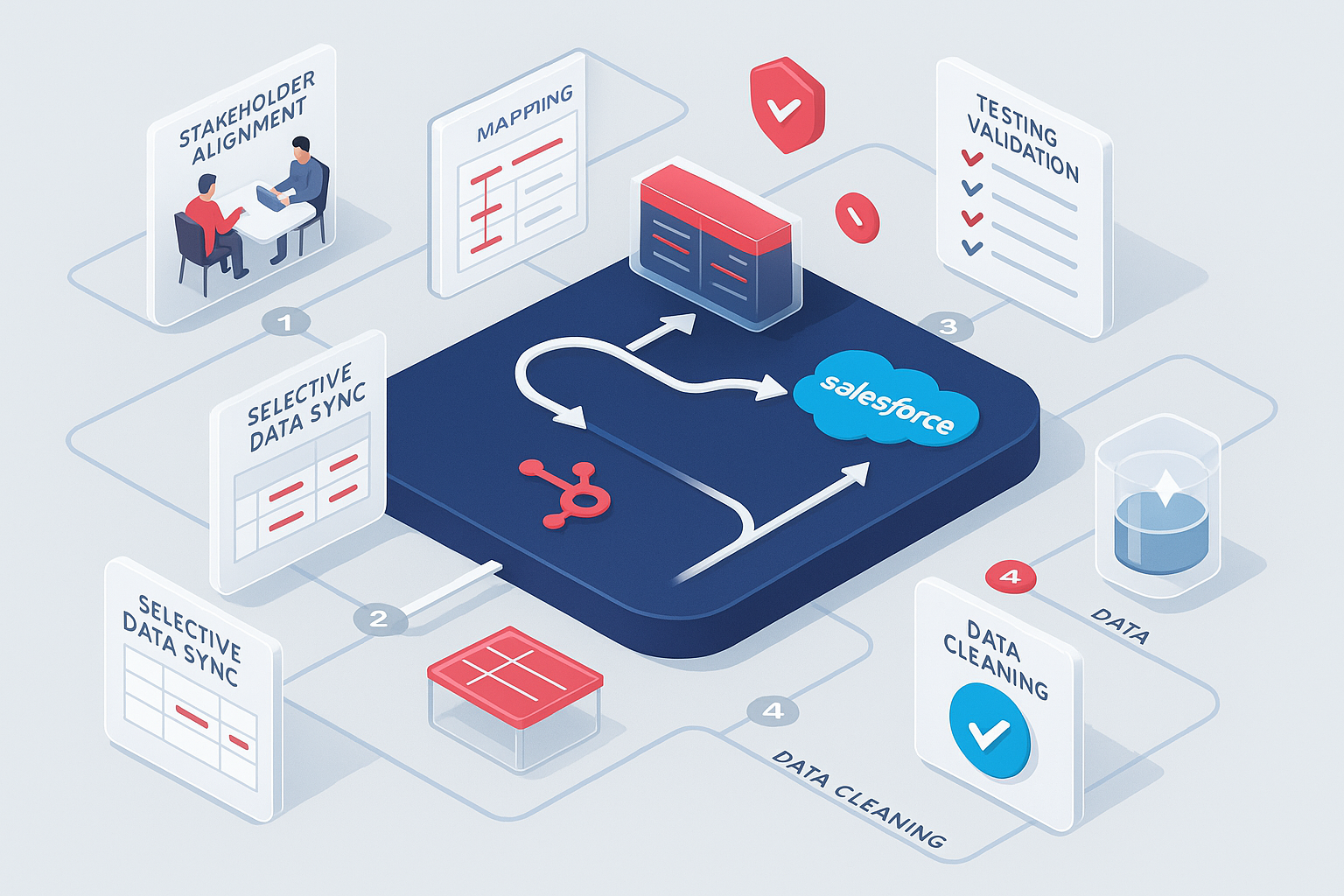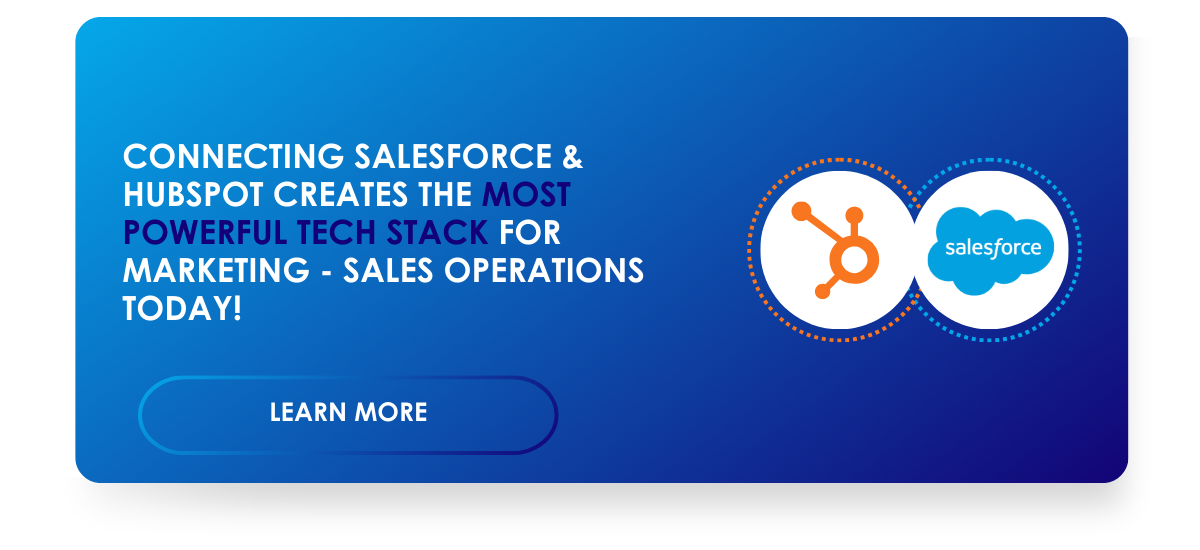5 tips for a successful HubSpot/Salesforce integration (upd. 2023)

One of the most powerful integrations HubSpot offers is the HubSpot/Salesforce integration, designed to enhance your CRM experience. Whether you're looking to streamline data synchronization, automate processes, or optimize your lead management, this integration offers a world of possibilities. In this blog, we'll delve into the intricacies of HubSpot and Salesforce integration, exploring best practices for data mapping, lead management, and more. Discover how to enhance your CRM capabilities and achieve a seamless marketing and sales alignment with HubSpot and Salesforce.
1. INVOLVE ALL RELEVANT STAKEHOLDERS
Integrations aren’t a purely technical matter, it’s a business integration project that needs to involve your sales and marketing departments. It is important to meet the needs of both teams, and to ensure they will work together to handover leads and contacts properly. Therefore, make sure that a key user from your sales back-office and another one from your HubSpot team can have their say on the integration. They are the ones whose needs need to be met!
2. ONLY SYNC THE DATA YOU NEED
When it comes to data synchronization, achieving efficient data synchronization methods is your best friend. Unnecessary data can complicate your setup, testing, and maintenance down the road. So, before you dive into data syncing, it's essential to adopt a less-is-more approach for streamlining data integration for success.
#1 Start with the Essentials
Begin your data integration journey by focusing on what's truly essential. Before syncing any data, ask yourself these questions:
- Does your Marketing team genuinely need that phone number in HubSpot?
- Is it necessary to trigger notifications in HubSpot for every event in Salesforce, or can you apply best practices for clean data synchronization?
For a solid foundation, consider starting with fundamental data, such as Accounts and Contacts, and expand as you become more comfortable with the integration process and minimizing complexity in data integration.
#2 Avoid Data Overload
Another vital aspect to consider is the clutter of information in your HubSpot account. If certain fields in Salesforce aren't used for creating workflows, it's best to display them through the HubSpot VisualForce iframe, instead of inundating your HubSpot interface. This will lead to improving data integration efficiency, which is crucial for a smoother experience for your teams.
Remember that too much information can lead to inefficiency. Keeping your data synchronization clean and lean not only reduces clutter in data syncing but also ensures a smoother experience for your teams.
3. DATA MAPPING
Creating a mapping table is crucial for integrating data between HubSpot and Salesforce. This table helps you track synchronized information and identify any discrepancies between the two systems. Two key considerations are:
- Master System: Decide which system serves as the master for each field to maintain data accuracy.
- Sync Direction and Prioritization: Define the synchronization direction for each field. Some fields, like "Lead Score," may be more Marketing-Oriented and should be primarily managed by HubSpot. If the lead seems to be Sales Qualified than the contact should be synced to Salesforce.
- Utilize Sync Rules to prevent overwriting essential data.
-
-
- People might put fake first/last name in HubSpot forms, and you might want to prevent this error to overwrite your (probably more accurate) Salesforce data! The Salesforce integration with HubSpot allows to put in place sync rules, which helps you decided whether or not certain fields like first name and last name may be overwritten.
-
-
Including technical names in the table helps ensure precise mapping. By addressing these factors, you streamline data integration and maintain accuracy in both HubSpot and Salesforce.
4. DATA CLEANING FOR A SEAMLESS INTEGRATION
Data cleaning is an essential step in the data integration process between HubSpot and Salesforce. It involves identifying and rectifying inaccuracies, inconsistencies, and redundancies within your datasets. The key steps include identifying data issues, standardizing data, de-duplicating records, handling missing data, validating data integrity, and maintaining thorough documentation. Data cleaning ensures that your integrated systems function effectively, minimizing errors, enhancing the user experience, and maximizing the benefits of your HubSpot and Salesforce integration.
5. TESTING DATA INTEGRATION FOR RELIABILITY
Testing is a critical phase in any data integration project, ensuring that the synchronization process runs smoothly and that data remains accurate & consistent across systems. Even by following the few guidelines we've provided above, there might be scenarios that you can't envision when designing the integration. So, it is important to test it first in parallel environments.
-
-
- Copy your production Salesforce data into a sandbox tenant.
- Synchronize first with a test HubSpot portal that also reflects your existing HubSpot system.
-
In this parallel environment, your end-users should thoroughly test all scenarios and verify that the integration corresponds to their needs and business cases. While testing, it's essential to notice what kind of synchronization errors you encounter in the HubSpot logs. This valuable information will aid in your data cleaning exercise.


